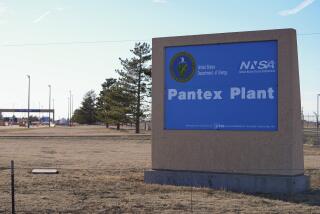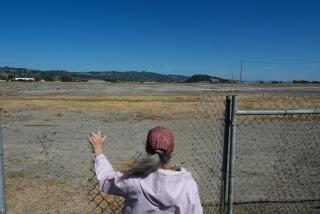U.S. government proposes 17-year delay in start of Hanford nuclear tank cleanup -- until 2039
The Energy Department has proposed a 17-year delay in building a complex waste treatment plant at its radioactively contaminated Hanford site in Washington state, pushing back the full start-up for processing nuclear bomb waste to 2039.
The department submitted the 29-page plan in federal court as part of a suit to amend an agreement with the state that requires the plant to start operating in 2022.
A series of serious technical questions about the plant’s design have caused one delay after another. Two of the major facilities at the cleanup site, which resembles a small industrial city, are under a construction halt ordered in 2013 by then-Energy Secretary Steven Chu.
The plant, located on a desert plateau above the Columbia River, is designed to transform 56 million gallons of radioactive sludge, currently stored in underground tanks, into solid glass that could theoretically be stored for thousands of years.
The waste was a byproduct of plutonium production, which started with the Manhattan Project during World War II.
The 586-square-mile Hanford site is widely considered the most contaminated place in the country, requiring 8,000 workers to remediate half a century of careless industrial practices that were done under strict federal secrecy.
The Energy Department filing shows the extent of the problems.
A 2014 review, conducted by a panel of the nation’s leading nuclear and chemical engineers, found that the partially built plant had 362 “significant design vulnerabilities,” including seals that could melt and ventilation systems that might not be able to contain radioactive gases.
Construction was stopped before that review when doubts surfaced that the complex technology for mixing of heavy sludge in large tanks would not be vigorous enough to prevent explosive hydrogen gas from forming or clumps of plutonium from starting spontaneous nuclear reactions.
The Energy Department’s legal filing cites those two issues as ongoing concerns.
The latest delay was disclosed Friday, when the Energy Department and Washington state submitted proposals to modify the 2010 agreement for cleaning up the tank waste. Under the Energy Department’s plan, all of the operations at Hanford’s waste treatment plant would be operational by 2039, though parts could start sooner.
Washington regulators have been pushing the Energy Department to comply with the agreement but have acknowledged that a delay is inevitable. The state has proposed a start-up for full operations by 2034, a 12-year delay.
The Hanford plant consists of three main facilities: a high-level melter plant that would convert the most radioactive waste into glass, a low-level melter plant that would vitrify less deadly material, and a pretreatment plant that would separate waste for the melters.
The low-level melter facility is the only plant that is still being built. Under a revised plan, the Energy Department hopes to use that part of the operation early, sending untreated waste into it for vitrification.
In a statement Wednesday, the Energy Department said it “remains committed” to completing the project. Other aspects of the Hanford cleanup, including remediation of contamination buildings, are continuing, they say.
The statement raises the possibility that if the low-level melter can be completed on its current schedule, some wastes could start being vitrified as early as 2022.
The new schedule is certain to affect the cost of the plant, which has been set for years at about $12 billion. But final cost will be impossible to determine until the technical issues are resolved and a new construction schedule set.
Tom Carpenter, executive director of the watchdog group Hanford Challenge, said the latest delay raises serious cost issues. Carpenter noted that the federal government has been spending $690 million annually on the waste treatment plant for more than a decade.
“Will Congress go along with funding the WTP at this rate for another 25 years or more, just to get the plant operational?” he said in an email.
Another unknown is how the delay will affect plans to complete the Hanford tank cleanup. Under the original design, the plant was designed to turn out each day 6 metric tons of vitrified high-level waste and 30 tons of vitrified low-level waste. If the plant had started in 2022 and met those production goals, it could have completed the job in about 40 years, or by 2059.
But now, that completion date could be pushed out to late in this century. The waste is being stored largely in single-shell steel tanks, some of which have leaked. The potential for additional leaks grows with time.
The Energy Department filing proposed a plan for removing the waste from some of the single-shell tanks through 2024. The department has built some new double-wall tanks that are considered safer. Under the new plan more would be required.
Twitter: @rvartabedian







